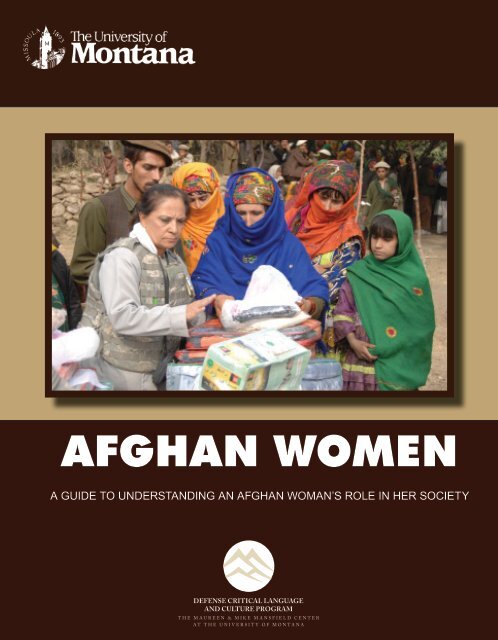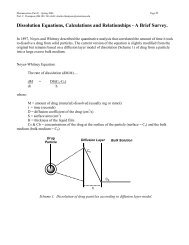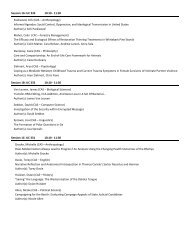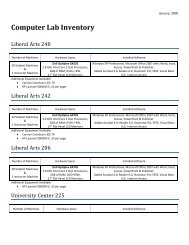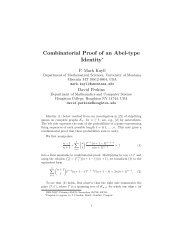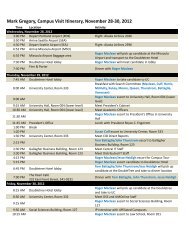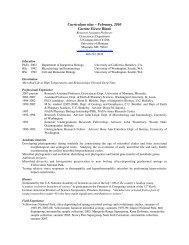AFGHAN WOMEN - The University of Montana
AFGHAN WOMEN - The University of Montana
AFGHAN WOMEN - The University of Montana
Create successful ePaper yourself
Turn your PDF publications into a flip-book with our unique Google optimized e-Paper software.
<strong>AFGHAN</strong> <strong>WOMEN</strong><br />
A GUIDE TO UNDERSTANDING AN <strong>AFGHAN</strong> WOMAN’S ROLE IN HER SOCIETY<br />
DEFENSE CRITICAL LANGUAGE<br />
AND CULTURE PROGRAM<br />
THE MAUREEN & MIKE MANSFIELD CENTER<br />
AT THE UNIVERSITY OF MONTANA
iii
Cover photograph © dvidshub.net. Other photos ©dvidshub.net and istockphoto.com<br />
Copyright © 2012. All rights reserved and copyrighted by Defense Critical Language/<br />
Culture Program, Maureen and Mike Mansfield Center at the <strong>University</strong> <strong>of</strong> <strong>Montana</strong><br />
2675 Palmer Street, Suite D, Missoula MT 59808<br />
Tel: 406-243-3600<br />
http://www.umt.edu/mansfield/dclcp<br />
Any opinions, findings, and conclusions or recommendations expressed in this material<br />
are those <strong>of</strong> the author(s) and do not necessarily reflect the views <strong>of</strong> the National Security<br />
Education Program (NSEP).<br />
DEFENSE CRITICAL LANGUAGE<br />
AND CULTURE PROGRAM<br />
THE MAUREEN & MIKE MANSFIELD CENTER<br />
AT THE UNIVERSITY OF MONTANA<br />
Caption for the image on the cover:<br />
A woman from the Wagel Valley brings her daughters with her to assist in carrying items<br />
distributed during a humanitarian mission in Dudarek, Afghanistan. An interpreter from the<br />
Nangarhar Provincial Reconstruction Team, left, makes sure the villagers receive all <strong>of</strong> the<br />
items available.<br />
iv
CONTENTS<br />
Acknowledgements viii<br />
Introduction ix<br />
<strong>The</strong> Afghan Family 1<br />
Greetings 3<br />
Reputation and Shame <strong>of</strong> the Family 6<br />
Making Food for the Family 8<br />
Fetching Water 10<br />
Washing Clothes 11<br />
Feeding Livestock 12<br />
Superstitions Among Afghan Women Not Related to Islam 13<br />
Women’s Roles in Afghan Villages 15<br />
Women’s Clothes 17<br />
Celebrations 19<br />
Marriage 20<br />
Maher and Dowry 23<br />
Bride Price 24<br />
Divorce 25<br />
Widowed Women 26<br />
Women’s Rights Under Islam 27<br />
Education 28<br />
Women’s Health 30<br />
Violence Against Women 32<br />
Women’s Lives Before 30 Years <strong>of</strong> War (Pre-1980) 34<br />
Afghan Women’s Lives During Three Decades <strong>of</strong> War 35<br />
Women’s Lives Between 2001 and the Present 37<br />
What Changes Should Be Made for Women 38<br />
Assistance that the US Military Can Bring 39<br />
Establishing Good Relations with Afghan Women in Villages 42<br />
A Step by Step Guide for Establishing Contact with Afghan Women 45<br />
v
ACKNOWLEDGEMENTS<br />
My colleagues at the Defense Critical Language and Culture Program<br />
were invaluable during the creation <strong>of</strong> this book. I thank them for their<br />
thoughtful input and their willingness to share their own personal histories.<br />
Most importantly I want to thank Retired U.S.A.F. Major General Don<br />
Loranger, Director <strong>of</strong> the Defense Critical Language and Culture Program,<br />
<strong>The</strong> <strong>University</strong> <strong>of</strong> <strong>Montana</strong>, for not only encouraging me every step <strong>of</strong> the way<br />
to write about my personal experiences but for having the confidence and trust<br />
in me allowing me to create this for our American military personnel. I, and<br />
the women <strong>of</strong> Afghanistan, thank you from the bottom <strong>of</strong> our hearts.<br />
vii
Author<br />
Shaima Khinjani was born and raised in Kabul, Afghanistan. During<br />
the Taliban regime, she opened an in-house school to teach girls and<br />
women to read and write. Later she worked as a program manager and<br />
gender consultant in the Afghan Independent Election Commission (IEC),<br />
as an evaluation consultant for the German Technical Cooperation (GTZ)<br />
Gender Mainstreaming. Khinjani also worked as an executive assistant to<br />
the Minister <strong>of</strong> Women’s Affairs in Kabul. Shaima is currently working<br />
towards her M.A. in Political Science at <strong>The</strong> <strong>University</strong> <strong>of</strong> <strong>Montana</strong>. She<br />
previously earned her B.A. in International Studies and Political Science<br />
with a focus on the Middle East/Islamic States from Ramapo College in<br />
New Jersey.<br />
viii
INTRODUCTION<br />
Typically village women in Afghanistan do not speak with men, especially<br />
foreign men in military uniforms. Afghan women are restricted by their culture<br />
and are sensitive to cultural issues. <strong>The</strong>y accept their lives and rarely question<br />
the restrictions placed on them by society, religion and Afghan culture. To<br />
open up communication with this half <strong>of</strong> the Afghan population, female<br />
military personnel must understand common cultural practices, social norms,<br />
and possess basic language skills in order to engage appropriately with Afghan<br />
women in villages.<br />
This book is designed to help American military personnel learn about Afghan<br />
women, the socially constructed norms that affect women’s lives, and Afghan<br />
cultural practices. Moreover, this book provides female military personnel with<br />
knowledge <strong>of</strong> women’s issues in Afghanistan prior to deployment in order to<br />
help them avoid culture shock and cultural misunderstandings.<br />
<strong>The</strong> contents <strong>of</strong> this book will also assist female military personnel in<br />
building trust and strengthening relationships with Afghan civilians, in<br />
particular Afghan women. In addition, female military personnel can gain a<br />
better understanding <strong>of</strong> women’s concerns and feelings about the US military.<br />
This information will help the US military direct activities that meet the<br />
people’s needs that, in turn, will help them win the hearts and minds <strong>of</strong> the<br />
Afghan people. Furthermore, the effective engagement with Afghan women<br />
will lead to the improvement <strong>of</strong> the lives <strong>of</strong> Afghan women.<br />
Most Afghan village women live in silence as they have no voice or choices.<br />
American female military personnel can give Afghan women a voice and a<br />
sense <strong>of</strong> recognition that can influence the behavior <strong>of</strong> Afghan men towards<br />
them. American female military personnel can be a liaison between Afghan<br />
ix
village women, non-pr<strong>of</strong>its, and other organizations designed to help them.<br />
Because US female military personnel <strong>of</strong>ten travel to places that no one else<br />
does, female military personnel can relay information from remote villages to<br />
organizations that help women.<br />
With knowledge <strong>of</strong> Afghan women’s lives, female military personnel can<br />
better interact with Afghan women which will allow them to gain access to<br />
information. Sharing this information with their units lessens the chances that<br />
American military personnel will act in a way that creates hatred and fear <strong>of</strong><br />
the American military.<br />
<strong>The</strong> information in this book is based on the personal knowledge <strong>of</strong> the<br />
Afghan instructors at the DCLCP all <strong>of</strong> whom have experienced the social and<br />
cultural changes in Afghanistan during three decades <strong>of</strong> war and poverty. This<br />
document reflects their and their family’s experiences both in the rural and<br />
urban settings. This book is in no way meant to represent all the experiences<br />
<strong>of</strong> Afghan women but only to serve as a guide to assist US military personnel<br />
when interacting with Afghan women. <strong>The</strong> sole purpose <strong>of</strong> this material is to<br />
help build better relations between Afghans and the US military.<br />
x
Female Afghan National Police members listen to a<br />
speech during an ANP female recruiting conference. <strong>The</strong><br />
two-day conference covered how to recruit and train an<br />
additional 5,000 women.<br />
xi
xii
In Afghanistan<br />
the family is the most<br />
important element<br />
<strong>of</strong> a woman’s life.<br />
Often an Afghan<br />
family is made up<br />
<strong>of</strong> a woman, her<br />
husband, sons,<br />
daughters, father-inlaw,<br />
mother-in-law,<br />
brother-in-law, sisterin-law,<br />
grandmother,<br />
grandfather and<br />
grandchildren, and<br />
they all live under<br />
one ro<strong>of</strong>. A typical<br />
Afghan family has<br />
THE <strong>AFGHAN</strong> FAMILY<br />
An Afghan family walks in the market with their three<br />
boys.<br />
from six to ten children. While families in cities tend to be smaller, people<br />
still live with their extended families. <strong>The</strong> senior woman, usually the motherin-law,<br />
controls the household affairs including overseeing the other women in<br />
the house.<br />
However, men control the financial affairs. Men are responsible for the<br />
family’s financial affairs since most women do not work outside the home.<br />
Men work and provide everyone in the family with food, clothes and other<br />
needs. <strong>The</strong> woman’s duty is to stay home, cook, clean the house, raise the<br />
children, weave, and sew. In some parts <strong>of</strong> Afghanistan, women make rugs<br />
1
and carpets for sale, although the money<br />
from the sale <strong>of</strong> these rugs and carpets is<br />
controlled by the men. Still, some women<br />
sell eggs, milk and spices from the family<br />
farm, and they <strong>of</strong>ten keep this money<br />
for themselves, which they tend to spend<br />
on their children or contribute to the<br />
household if needed. In big cities, women<br />
work as doctors, lawyers, teachers, nurses,<br />
engineers and civil servants. Some women<br />
work for local and international NGO’s.<br />
2<br />
Women in Afghanistan - DCLCP<br />
Out <strong>of</strong> 23.6 million<br />
people in Afghanistan,<br />
48.9% are female.<br />
Women head 2% <strong>of</strong><br />
Afghan households.<br />
(UNIFEM Afghanistan<br />
Fact Sheet 2008)<br />
Reputation is also very important in the family, and women are the primary<br />
source <strong>of</strong> a family’s reputation. A woman’s reputation depends on her obeying<br />
and respecting the rules and regulations that have been established by the men<br />
in the family. Men make decisions for all members <strong>of</strong> the family including their<br />
children. However, in some families the senior women such as the mother-inlaw<br />
is also involved in family decision-making. <strong>The</strong> men in the family always<br />
look after women and girls, and when girls grow into old women, their sons<br />
look after them if their husbands can no longer do so. Women cannot make<br />
independent decisions on their own at any time in their lives.
GREETINGS<br />
Greetings in Afghanistan vary according to gender. For example, Afghan<br />
women do not kiss or shake hands with most men, but they do shake hands<br />
with close male family members such as their fathers, brothers and uncles.<br />
When unrelated men greet Afghan women, they put their hands on their own<br />
chest and say “Salam alaykum.” Men do not say a woman’s name when greeting.<br />
Instead they will call her “hamshera” in Dari or “khori” in Pashto meaning<br />
“sister” However if they greet older women, they will call them “mother jan”<br />
in Dari or “mori” in Pashto meaning “mother.” <strong>The</strong> most important point for<br />
men to remember when greeting Afghan women is that they must never touch<br />
an Afghan woman, even to shake hands, must keep their distance and must not<br />
say the woman’s name.<br />
US military women have more flexibility in greeting an Afghan woman.<br />
<strong>The</strong> most common way for women to greet in Afghanistan is three kisses on<br />
the cheeks. A typical Afghan greeting lasts at least five minutes because they<br />
will ask about you, your health, and your family members and so on. A short<br />
hello or wave like an American greeting would be considered <strong>of</strong>fensive, and the<br />
person might think that you are upset with them. Also a younger person would<br />
kiss an older persons hand in greeting, especially among close family members.<br />
<strong>The</strong> younger person begins the greeting.<br />
In family life, women are in charge <strong>of</strong> hospitality. If a female guest comes<br />
to the family home, the male member <strong>of</strong> the family will only say “Salaam” and<br />
then call the women in the family to come to the door to receive the guest.<br />
<strong>The</strong>n, after a long greeting among the women, the guest would be taken into<br />
the house and asked to sit down away from the door. Placing a guest as far away<br />
from the door is a sign <strong>of</strong> respect. <strong>The</strong> elders, who are the most respected people<br />
3
4<br />
Women in Afghanistan - DCLCP<br />
Navy Lt. J.G. Tamora Holland, Paktika Provincial Reconstruction Team medical<br />
<strong>of</strong>ficer and Female Engagement Team leader from Pittsburgh, PA, greets an Afghan<br />
woman at the province’s first women’s shura.
5<br />
Women in Afghanistan - DCLCP<br />
in the family, and guests are always seated far from the door. Children sit closer<br />
to the door since they are lower on the hierarchal ladder in Afghan society.<br />
Tea will be made immediately upon the guest’s arrival as a show <strong>of</strong> respect<br />
and goodwill. Guests also accept tea as a reciprocal sign <strong>of</strong> respect. <strong>The</strong> men<br />
will leave the room, but the children, especially the younger children, may<br />
stick around. While they will be curious about the American women, they will<br />
probably be shy. Some may stay in the room, especially the younger ones, and<br />
others may leave the room, but still peek out at the American women from time<br />
to time. If a child approaches a guest, it is okay for the guest to speak to the<br />
child and even to touch the child on the arm or shoulder as a sign <strong>of</strong> warmth<br />
and assurance.<br />
Saying goodbye is the same as saying hello with kissing, only you don’t say<br />
“Salaam.” You say “Khuda afiz” which means “Good bye.”
REPUTATION AND SHAME OF<br />
THE FAMILY<br />
Women carry the family’s<br />
reputation, and men keep the<br />
honor <strong>of</strong> the family by strictly<br />
controlling the women so<br />
that they do not bring shame<br />
to the family. Since women<br />
are the primary source <strong>of</strong> a<br />
man’s shame, women try at<br />
all costs to avoid actions that<br />
bring shame to the man or<br />
the family.<br />
Women are expected to be<br />
as modest as possible. <strong>The</strong>ir<br />
faces must be covered and<br />
only revealed to the husband,<br />
some close male members <strong>of</strong><br />
the family and other women.<br />
For men the most important<br />
elements <strong>of</strong> life are women,<br />
money and property. If any<br />
sort <strong>of</strong> transgression occurs<br />
regarding women, money<br />
or property, the owner will<br />
be dishonored, and will<br />
seek revenge by committing<br />
serious actions against the<br />
A local Afghan woman, along with her<br />
children, are searched by Army Sgt. Peggy Hart,<br />
176th Engineer Brigade combat medic, before<br />
entering the room where the first women’s<br />
shura was held.<br />
6
7<br />
Women in Afghanistan - DCLCP<br />
transgressor. <strong>The</strong>se actions could include killing, beating or repeating the<br />
transgression that occurred against him or his family.<br />
Among some Afghan tribes in southern Afghanistan, a shame that is brought<br />
upon one family is a shame brought upon the entire tribe. For instance, if a<br />
young woman has a boyfriend and runs away with him, this will bring dishonor<br />
to the entire extended family group. If the family does nothing to regain the<br />
honor <strong>of</strong> the family, members <strong>of</strong> the tribe will come to the family and demand<br />
that they do something to restore the honor <strong>of</strong> the entire tribe. This is one <strong>of</strong> the<br />
most serious dishonors, and in order to regain the family honor, the boy and the<br />
girl who ran away might be killed. If the boy cannot be found, a woman in his<br />
family might be kidnapped or given to the other family to end the animosity.<br />
This back and forth fueding to regain honor could go on for years. Sometimes<br />
a tribal Jirga is called to end the animosity between the families. Daughters,<br />
sheep and/or money may be exchanged to end the bad blood between the two<br />
families.
MAKING FOOD FOR THE<br />
FAMILY<br />
A group <strong>of</strong> Afghan women and Air Force Capt. Jillian Torango <strong>of</strong> the Panjshir<br />
Provincial Reconstruction Team, participate in a women’s shura in Sangee village,<br />
Anaba District, Afghanistan, Aug. 4, 2008.<br />
Food preparation is an important part <strong>of</strong> Afghan culture and is typically a<br />
job for women. Women spend a lot <strong>of</strong> time in the kitchen cooking for the entire<br />
family and are expected to be good cooks. However, in restaurants and at big<br />
ceremonies such as weddings, men cook, though cooking is still one <strong>of</strong> the most<br />
important skills for a woman. Sometimes a man uses alleged poor cooking skills<br />
<strong>of</strong> his wife as an excuse to marry another woman. In some families men get angry<br />
8
9<br />
Women in Afghanistan - DCLCP<br />
at the women if the food is not well cooked. Afghans <strong>of</strong>ten take guests out to<br />
restaurants for dinner or lunch, but they also like to bring guests home. Serving<br />
guests food at home is common as Afghans love to have guests. Also a man<br />
takes pride in his wife’s cooking ability in the presence <strong>of</strong> guests; therefore, poor<br />
cooking skills bring shame to men in front <strong>of</strong> other men.<br />
Women <strong>of</strong>ten use wood for cooking especially in villages where they do not<br />
have electricity or gas. It is a woman’s job to make meals three times a day for<br />
the family. Serving three meals a day on time is a sign <strong>of</strong> discipline in the house<br />
and shows the woman’s ability to serve the family. <strong>The</strong> three meals a day include<br />
breakfast that usually consists <strong>of</strong> tea, sugar, milk, eggs, and bread fried in oil<br />
called “nani roghani.” Lunch is usually lamb soup, “shorba” with tandoori bread,<br />
while dinner <strong>of</strong>ten consists <strong>of</strong> rice with lamb and vegetables. All meals are served<br />
in the dining area on the floor called “destarkhwan.” In some families, men and<br />
women eat separately. <strong>The</strong> men eat first and whatever is left goes to the women.<br />
Most Afghans do not use silverware. Instead they eat with their right hand.<br />
Eating with the left hand is considered improper since it is used for washing<br />
private parts. Since food is considered sacred, using the right hand shows respect.<br />
Before eating, the host will bring water so that guests can wash their hands.<br />
After everyone washes their hands, the elder person starts the meal by invoking<br />
the name <strong>of</strong> God. Everyone else will repeat after the host and then start eating.<br />
At the end <strong>of</strong> the meal, they will again thank God and say a prayer for the host<br />
family. Only the women <strong>of</strong> the family clean and wash the dishes. After the food<br />
is finished, tea with some candy will be served.<br />
Some famous and delicious Afghan food includes “qabili palau” which is rice<br />
with chopped and fried carrots and raisins, beef dumplings called “aushak” and<br />
vegetable dumplings which are called “bulanni.” <strong>The</strong>se are the most delicious<br />
Afghan specialties, and only special guests are served this food. “Awasana” means<br />
special food. In Afghanistan, expected and unexpected guests are always welcome.<br />
Guests are served as well as possible. This is an important part <strong>of</strong> Afghan culture.
As mentioned before,<br />
Afghan women and girls<br />
cannot go outside their home<br />
without the permission<br />
<strong>of</strong> the men. When they<br />
are allowed to go out, it is<br />
usually to bring water from<br />
the river since there is no<br />
running water inside village<br />
houses. Women usually put<br />
containers <strong>of</strong> water on their<br />
heads and bring them home.<br />
Women usually fetch water<br />
in the morning and late<br />
afternoon as a group. <strong>The</strong><br />
FETCHING WATER<br />
A local Afghan woman holds her child while<br />
gathering water from a river in Uruzgan Province,<br />
Afghanistan.<br />
river is a place where village women get the chance to talk and interact with<br />
each other. <strong>The</strong>refore, fetching water is not unpleasant work. Rather it is fun<br />
because it gives women a chance to see each other. Women mostly get village<br />
news from each other when they go get water. <strong>The</strong>y chat and talk about issues<br />
going on in the village such as what happened to some families, who is getting<br />
married and so on.<br />
Unfortunately, river water is not clean, but village people do not have any<br />
other choices. Sometimes women wash clothes, carpets and other things in the<br />
river while downstream other people drink the same water. Another problem<br />
with drinking river water is that most river water is from melted snow. Since<br />
this water lacks iodine, many women get goiters.<br />
10
WASHING CLOTHES<br />
Washing everyone’s clothes in an Afghan family is also a woman’s job.<br />
Usually the younger women in the family wash clothes by hand, and then<br />
put them in the sun to dry. <strong>The</strong>n she irons them and gives them to the men <strong>of</strong><br />
the house when she is asked. If a man’s clothes are not washed or ironed well,<br />
everyone says that it is his wife’s fault. If a man wears clean and ironed clothes,<br />
people, especially the man’s friends, will compliment him for having such a<br />
good wife.<br />
<strong>The</strong>re are washing machines in Afghanistan, but only rich families with<br />
electricity have washing machines. In the village, women wash clothes outside<br />
the home in nearby rivers. <strong>The</strong>y <strong>of</strong>ten call each other and go wash clothes together<br />
as a group. Every woman washes her own family’s clothes, but going as a group<br />
makes this hard work more bearable because the women tell jokes and make fun<br />
<strong>of</strong> each another. Together, they turn the work into a social gathering. Women<br />
rarely get the chance to go out, so this gathering is one <strong>of</strong> the only times where<br />
they can talk and interact with women outside their families. This is also a place<br />
where women talk about their husbands, their children, their concerns and their<br />
problems as well as gossip about their mothers-in-law and other women.<br />
Though you may see women at the river washing clothes and socializing,<br />
it is best if soldiers and marines, even females, do not approach them at the<br />
river. A female wearing full body armor after having just arrived in a Humvee<br />
approaching the women may frighten them.<br />
11
FEEDING LIVESTOCK<br />
Feeding livestock is another household responsibility for women. Cows,<br />
goats, sheep, and chickens are the most common livestock in Afghanistan.<br />
Women in the family feed and clean these animals and make sure they produce<br />
enough milk for the children. Extra milk is sold to the neighbors. Selling milk<br />
is one <strong>of</strong> the few ways in which women can make a little money. Some families<br />
don’t even give the milk to their kids. Instead they sell the milk and buy other<br />
food instead. Women and girls also make yogurt, cheese, sweets and other<br />
milk products to sell at the local markets. Culturally, this is a respected job for<br />
woman, especially widows without other means <strong>of</strong> support. This is the only<br />
way they can earn money and get food to meet their family’s basic needs.<br />
Women <strong>of</strong>ten help each other when their cows or other animals are sick<br />
because there are few veterinarians available in the villages. However, there are<br />
many NGOs such as Oxfam International that train women on basic medical<br />
care <strong>of</strong> animals.<br />
Income through livestock is very important for women in Afghan villages.<br />
A woman’s contribution to the family’s income increases her status. Without<br />
this financial contribution, women and girls are considered consumers, so girls<br />
will <strong>of</strong>ten be given in marriage at an early age since they are regarded as an<br />
economic liability. On the other hand, sons are considered economic resources.<br />
Sons provide for their parents later in life. Good food, health, and education<br />
for sons are considered an investment for the parent’s future when they get old.<br />
12
SUPERSTITIONS AMONG<br />
<strong>AFGHAN</strong> <strong>WOMEN</strong> NOT<br />
RELATED TO ISLAM<br />
As in many cultures, the Afghan people hold a variety <strong>of</strong> superstitions based<br />
on ancient culture and old wives’ tales. Here is a list <strong>of</strong> the most common old<br />
wives’ tales.<br />
• Sweeping the house at night is a sin.<br />
• When a bride leaves her parents’ house, no cleaning should be done<br />
right away.<br />
• When someone travels out <strong>of</strong> the country, women at home do not sweep<br />
that day.<br />
• When someone in the family dies, women do not wash their clothes for<br />
three days.<br />
• Women should not go out <strong>of</strong> the house for forty days and, in some cases,<br />
for one year after a family death.<br />
• When a bird comes to the tree in the yard and sings, news from a traveler<br />
will come.<br />
• When a cat washes its face, a guest will come.<br />
• When a dog cries, bad news will come.<br />
• When kids touch a broom, guests will come.<br />
• You should not cut your nails at a friend’s house.<br />
• You should cut your hair at your friend’s house if you are very fond <strong>of</strong><br />
the friend.<br />
• Girls shouldn’t wash their hands when going to their father’s home the<br />
first day after their own wedding.<br />
13
14<br />
Women in Afghanistan - DCLCP<br />
• When the right palm itches, that person will receive money. When the<br />
left hand itches, that person will lose money.<br />
• When a new bride comes to her in-law’s home and good things happen,<br />
she is thought to bring good luck to the family. When bad things<br />
happen, she is considered bad luck for the family.<br />
• You should hang an onion on the neck <strong>of</strong> the person who is suffering<br />
from jaundice.<br />
• It is said that people get tuberculosis and vitiligo (depigmentation <strong>of</strong><br />
patches <strong>of</strong> skin) because God is upset with them.<br />
• When a person suffers frequently from any kind <strong>of</strong> sickness, people say<br />
God is upset with him/her.<br />
• If children do not keep their parents happy, they will never be happy in<br />
life.<br />
• When women have bad dreams they should not share them with any<br />
one. <strong>The</strong>y should only tell them to the river or another water source.
<strong>WOMEN</strong>’S ROLES IN <strong>AFGHAN</strong><br />
VILLAGES<br />
Women’s lives are challenging<br />
in Afghan society because <strong>of</strong><br />
the different social expectations<br />
for men and woman. <strong>The</strong>se<br />
expectations are harder on women<br />
and differ from city to village<br />
life. <strong>The</strong>re are more limitations<br />
on village women than in urban<br />
areas. For instance, women must<br />
wear a burqa in public and little<br />
girls must wear veils. Old women<br />
only wear either a white or<br />
black veil. Village women have<br />
limited access to education and<br />
work. <strong>The</strong>y cannot go out alone.<br />
If people see a woman alone in<br />
public, even if she is wearing a<br />
burqa, they will judge her to be<br />
a bad woman. Young women are<br />
An Afghan woman sells pottery at a<br />
women’s bazaar in Kabul, Afghanistan,<br />
January 28, 2011.<br />
most vulnerable to this scrutiny so when they go outside their home to shop or<br />
to visit relatives, they must be escorted either by an older woman or by a young<br />
man from their family.<br />
<strong>The</strong> village people do not respect women who go out after dark. Women<br />
may not even be allowed by their family to go out at dusk or early evening.<br />
Even if they need to go out, they have to wait until the next day. Village women<br />
constantly live in fear <strong>of</strong> poor security and personal safety as well as negative<br />
15
judgment by society. <strong>The</strong>refore, they avoid<br />
speaking loudly, laughing, wearing fancy<br />
clothes or talking with each other in public.<br />
<strong>The</strong>y <strong>of</strong>ten avoid going out because village<br />
men might recognize the women from the<br />
color <strong>of</strong> their clothes and burqa and judge<br />
them.<br />
Sometimes women <strong>of</strong> the family get<br />
permission from the mother in-law to go<br />
shopping, but they must return before the<br />
men <strong>of</strong> the family come home. In most<br />
families, women are beaten if they go out<br />
without permission. Sometimes, families<br />
do not even allow women to go shopping<br />
and men bring them whatever they need.<br />
In some families where there is no older<br />
woman available, the men <strong>of</strong> the family<br />
lock the young women at home when they<br />
go to work for the day. Older women at<br />
home are considered to be protection for<br />
younger women.<br />
<strong>The</strong>re are some public places where only<br />
women can go, such as women’s gardens<br />
and shrines where women come together<br />
and pray. <strong>The</strong>re they <strong>of</strong>ten bring sweets<br />
such as “alwa” to share with each other.<br />
16<br />
Women in Afghanistan - DCLCP<br />
Of the 1,547 sitting<br />
judges in Afghanistan<br />
only 62 or 4.2% are<br />
female.<br />
Of the 546<br />
prosecutors, 35 or 6.4%<br />
are female.<br />
Of the 1,241 attorneys<br />
76 or 6.1% are female.<br />
(UNIFEM<br />
Afghanistan Fact Sheet<br />
2008)<br />
---------------------------<br />
<strong>The</strong>re are no women<br />
members in the Supreme<br />
Court Council.<br />
(UNIFEM<br />
Afghanistan Fact Sheet<br />
2008)
<strong>WOMEN</strong>’S CLOTHES<br />
Dress is one <strong>of</strong> the most important elements <strong>of</strong> Afghan culture. Women are<br />
encouraged to wear modest, long and loose dresses. Typically a woman’s dress<br />
consists <strong>of</strong> pants “tombaan,” an overdress “perahaan” and a head covering,<br />
“chadar.” However, in the cities, women dress more modern, but they still must<br />
cover their entire body, especially in public. Village women wear very colorful<br />
clothes although old women wear darker colors, and young women wear shiny,<br />
bright colors. Widows, regardless <strong>of</strong> age, are supposed to wear darker colors<br />
because traditionally married women wear nice and colorful dresses that are<br />
attractive to their husbands while widows do not have a husband so they must<br />
wear very modest clothing. Women <strong>of</strong> high status or newly married women<br />
wear more expensive fabrics.<br />
Village women mostly buy material and make their own clothes, but usually<br />
there is also a local female tailor who makes clothes at home with the material<br />
women bring to them. Young girls also generally wear the same style <strong>of</strong> clothes,<br />
i.e., tombaan, perahaan and a little chader. Some women make clothes for<br />
their children from the same material that they buy for themselves. If one sees<br />
young girls wearing the same color and fabric as a woman, then they know that<br />
those girls belong to that woman.<br />
For some women, expensive dresses show their love from their husbands.<br />
Other women may say that their husbands love them a lot because the men<br />
buy them nice things and expensive clothes. Jewelry, such as gold, is also very<br />
common. Women wear a lot <strong>of</strong> gold, mostly for special occasions, during which<br />
women show <strong>of</strong>f their jewelry and expensive clothes. This gives their husbands<br />
a sense <strong>of</strong> pride. Women generally congratulate each other on their new clothes<br />
and jewelry by saying, “May you wear your new clothes happily. “<br />
17
18<br />
Women in Afghanistan - DCLCP<br />
An Afghan woman from the north in a red party dress.
CELEBRATIONS<br />
<strong>The</strong>re are many festivals and celebrations in Afghanistan and women’s roles in these<br />
celebrations are important. “Nawroz,” first day <strong>of</strong> the New Year, falls on March 21.<br />
Women do extensive cleaning <strong>of</strong> the house one week leading up to Nawroz. <strong>The</strong>y make<br />
“aft mewa,” which is seven kinds <strong>of</strong> dried fruits, and serve it to the family after breakfast.<br />
Before serving aft mewa, everyone in the family gathers in one room and prays for the<br />
family’s happiness, safety and long life. After that people go to each other’s homes.<br />
Women also go out to kick and walk on the spring grass, “sabza laghat.” Another<br />
part <strong>of</strong> the celebration is cooking “samanak,” sweet pastries made from germinated<br />
wheat. Women have a special party while cooking samanak singing songs from nightfall<br />
until daylight. This is not only a party; it is a special party that is connected to women’s<br />
wishes, beliefs and emotions. Young girls come to this party and pray to find a suitable<br />
husband. Mothers also make wishes for their children.<br />
Eid Al-fitr (Eid Roza) and Eid Al- Adha (Eid Qurban) are two other important<br />
Muslim festivals in Afghanistan and other Islamic countries. Eid Al-fitr is celebrated<br />
at the end <strong>of</strong> Ramadan and lasts for three days. Again, women in the family lead these<br />
celebrations making delicious food, cookies and cakes. <strong>The</strong> night before, women and<br />
girls paint henna on their hands. People also make new clothes and men go to the<br />
mosque for special prayers while the women stay at home and finish cleaning. <strong>The</strong>y want<br />
to have everything ready before the men return from the mosque. Children get “eidi,”<br />
money from elders. Some women also get eidi from their husbands.<br />
Two and a half months after Eid al-Fitr is Eid Al-Adha. This is also a three-day<br />
celebration with feasts <strong>of</strong> sacrifice commemorating the Prophet Abraham’s devotion to<br />
God. People sacrifice goats, sheep, or cows and distribute the meat to poor families and<br />
relatives. Afghans also celebrate this festival by visiting each other.<br />
19
MARRIAGE<br />
In Afghanistan, marriage is <strong>of</strong> the utmost importance. Afghans say, “Without<br />
marriage, life and faith are incomplete.” <strong>The</strong>refore, there are few unmarried<br />
people in Afghanistan. Parents are always trying to find suitable partners for<br />
their sons and daughters. Marriage is traditionally a union <strong>of</strong> two families, rather<br />
than <strong>of</strong> two individuals.<br />
In Afghanistan there are many types <strong>of</strong> marriages including love marriages,<br />
exchange marriages, forced marriages, arranged marriages, and child marriages.<br />
<strong>The</strong> most common marriage is an arranged marriage in which the bride and<br />
groom share the same ethnicity, social class and level <strong>of</strong> reputation.<br />
In Afghanistan, marriage starts with the boy’s family going to the girl’s family<br />
to ask for her hand. <strong>The</strong>n the boy’s family visits the girl’s family from time to<br />
time. Sometimes, the girl’s family does not give an answer right away to the boy’s<br />
family because a quick answer implies that the girl’s family is eager to get rid <strong>of</strong><br />
her. If the boy’s family thinks that the girl’s family is eager to marry her <strong>of</strong>f, the<br />
boy’s family may think her worth less, and they too may value her less.<br />
In many families, it is too much <strong>of</strong> a dishonor for the family if the girl says no.<br />
Sometimes a girl’s own family will kill her if she dishonors the family by saying<br />
no to an arranged marriage or if she tries to escape a forced marriage. In general,<br />
however, most men can say no to the proposed bride, and men can have multiple<br />
wives even over the objections <strong>of</strong> their first wives.<br />
Afghan weddings are very costly in relation to a family’s income. In some<br />
tribes, a wedding can last for seven days and nights and the groom’s family pays<br />
all the expenses.<br />
In cities, weddings are expensive since they take place in fancy hotels with<br />
20
many different kinds <strong>of</strong> food. Village<br />
weddings occur in the homes <strong>of</strong> both the<br />
bride and the groom, and the ceremony is<br />
separate for men and women. <strong>The</strong> family<br />
also does not send invitations to people.<br />
Instead, women get together and go from<br />
house to house inviting people. People give<br />
the women some kind <strong>of</strong> sweet or other<br />
small token as a reward for inviting them to<br />
the wedding. But these days, given the poor<br />
security situation in much <strong>of</strong> Afghanistan,<br />
21<br />
Women in Afghanistan - DCLCP<br />
70% to 80% <strong>of</strong> women<br />
face forced marriage in<br />
Afghanistan.<br />
57% <strong>of</strong> girls are<br />
married before the legal<br />
marriage age <strong>of</strong> 16.<br />
(UNIFEMAfghanistan<br />
Fact Sheet 2008)<br />
people just announce that there will be a wedding the next day and that all the<br />
villagers are invited.<br />
Cousins marrying cousins is very common in villages because <strong>of</strong> inheritance<br />
rules and because most Afghans do not like a new person to come into their<br />
family. For this reason, they prefer marriages among cousins, even first cousins.<br />
A simple wedding consists <strong>of</strong> three different parts: the shab-e-henna, the<br />
wedding ceremony including nikah, and the takht jami. Shab-e henna happens<br />
one or two nights before the wedding night. At the shab-e henna, all the women<br />
get together to put henna on their hands. <strong>The</strong> wedding ceremony is after sheb-e<br />
henna. Nikah is the most important part <strong>of</strong> the wedding ceremony. Nikah is the<br />
religious part <strong>of</strong> the wedding that <strong>of</strong>ficially completes the marriage contract. A<br />
mullah and three male witnesses perform the nikah where the families <strong>of</strong> the<br />
bride and groom agree upon the marital contract. <strong>The</strong> bride, who is dressed<br />
up in green during nikah, cannot participate directly until nikah is finished.<br />
Instead, the three male witnesses go to her and ask her to pick a representative<br />
called “pather wakeel” who represents the bride’s wishes and decides the amount<br />
<strong>of</strong> money or property as maher.<br />
Takht jami is the last party, and it is usually three or seven days after the
22<br />
Women in Afghanistan - DCLCP<br />
wedding. This is also the women’s party where the bride’s family will bring her<br />
dowry and other gifts. <strong>The</strong> other relatives also bring gifts for the bride. When<br />
this party is over, the bride is ready to start working around the house and get to<br />
know everyone and everything in her new home.<br />
A local Afghan National Police Officer invites the Marines to his wedding because<br />
<strong>of</strong> the friendship created by the Police Mentor Team. Other Marines are invited as<br />
well and more than 30 attend the wedding.
MAHER AND DOWRY<br />
Maher is an obligatory amount <strong>of</strong> money promised by the groom to the<br />
bride at the time <strong>of</strong> the marriage contract. According to Islam, this money<br />
is like a gift (not the price) to the bride and she can spend it as she wishes.<br />
Sometimes this gift could be other things than money such as a house, a piece<br />
<strong>of</strong> land, a garden, gold or silver. <strong>The</strong> man may give only half <strong>of</strong> the Maher to<br />
the woman when they get married, and he pays the other half on a specific<br />
time agreed between parties. Payment <strong>of</strong> Maher is not conditional to divorce,<br />
it means the bride can ask for the full Maher or half or a portion at any time<br />
after marriage. If divorce happens after marriage and before consumation <strong>of</strong><br />
the marriage, the bride shall be entitled only to half <strong>of</strong> the full maher. Based<br />
on custom in Afghanistan, usually grooms do not pay maher until divorce<br />
happens. Many families make this amount large enough so the man cannot<br />
afford to divorce the woman. A woman can also tell her husband that he does<br />
not have to pay the maher at all.<br />
Unfortunately because <strong>of</strong> the bureaucracy and male-dominated judicial<br />
system in Afghanistan, it is very difficult for women to get their Maher when<br />
they divorce. In Afghanistan, where most women are uneducated, many<br />
women do not even know about this right, so they never even receive any part<br />
<strong>of</strong> their maher.<br />
Dowry is the gift given to the bride by her family, which is optional, not<br />
obligatory. This gift includes expensive clothes, gold, jewelry and household<br />
items. Often in an Afghan village wedding, few families give dowry, but all<br />
families must give pillows, blankets and a mattress to the bride called “pest-ekhwab.”<br />
23
BRIDE PRICE<br />
<strong>The</strong> bride price is the amount <strong>of</strong> cash or property given to the bride’s family<br />
by the groom’s family in order to obtain sole rights to the bride for economic,<br />
sexual, and reproductive services. While bride price is not a part <strong>of</strong> Islam, it is<br />
a common custom in Afghanistan. Bride price reflects the value <strong>of</strong> a woman.<br />
It goes up if the woman is very beautiful and has many valuable skills such as<br />
cooking and sewing. Among Turkmen tribes in Afghanistan, the bride price<br />
can be very high because the women can make carpets, a valuable skill for<br />
economic reasons. Some poor families force their girls to marry at a very young<br />
age to get the bride price so some marriages consist <strong>of</strong> a child bride with an<br />
adult groom, who in many cases has multiple wives.<br />
A lot <strong>of</strong> domestic violence in Afghanistan is associated with the bride price.<br />
Often when a girl’s father asks for a lot <strong>of</strong> money for his daughter, the groomto-be<br />
goes to Pakistan or Iran and works for years to make the money, but after<br />
the wedding, his family <strong>of</strong>ten does not treat the bride well. Often in this case,<br />
she is forced to do most <strong>of</strong> the work around the house. If she has skills such as<br />
making carpets, she is forced to make as many carpets as possible so that her<br />
husband can regain the money that he paid to the girl’s family.<br />
Sometimes people living in the same village argue over whether the bride<br />
price is too high or too low. For example, if a family pays more money in<br />
comparison to a previous wedding in the village, a villager may go to that<br />
family to say that the price they paid was too high for the village, and it is<br />
making life difficult for them. Also if a girl’s family takes less money than the<br />
last wedding in the village, families with more girls will come to their home<br />
and complain that the bride price was too low.<br />
24
DIVORCE<br />
Divorce is allowed in<br />
Islam, but most <strong>of</strong> the<br />
rights lie with the men;<br />
however, women do have<br />
the right to divorce under<br />
specific conditions and<br />
circumstances. In Islam,<br />
women can insist on their<br />
rights for divorce at the time<br />
<strong>of</strong> the marriage contract,<br />
“nikah.” For instance, she<br />
can tell her husband that she<br />
will marry him under the<br />
condition that he gives her<br />
An Afghan woman from central Afghanistan.<br />
the right to divorce him. In Afghan culture though, divorce is not encouraged,<br />
and most Afghan women do not even know their rights when it comes to filing<br />
for divorce. Also, since family is so important, divorce is considered breaking<br />
not only the relationship <strong>of</strong> two people but also the ties between two families.<br />
Life is extremely challenging for a divorced Afghan woman. People look<br />
down on her and think that she is not a good woman since a good woman<br />
never leaves her husband. Plus she becomes a burden for her family since most<br />
Afghan women do not work outside the home. Also her father’s family never<br />
wants to face the judgment and gossip <strong>of</strong> the people <strong>of</strong> the village. <strong>The</strong>refore,<br />
they encourage their daughters to be obedient to their husbands, put up with<br />
difficulties and avoid separation. Only in cases with extremely valid reasons for<br />
divorce is a woman supported by her family in a divorce.<br />
25
WIDOWED <strong>WOMEN</strong><br />
According to the United Nations Fund<br />
for Women (UNFW), there are more than<br />
one million widows in Afghanistan. Most<br />
<strong>of</strong> them live in poverty and are dependent<br />
on financial handouts from their relatives.<br />
Most widowed women in the provinces are<br />
illiterate and unable to support themselves.<br />
Men rarely marry a widowed woman,<br />
and only a widowed man would marry a<br />
widowed woman. If she has children, there<br />
is less chance for her to remarry. In some cases, if the widowed woman is<br />
young, her family might remarry her. <strong>The</strong>n either she or the dead husband’s<br />
family takes custody <strong>of</strong> the children. If the dead husband’s family takes the<br />
children, she will not be able to see her children nor will she have rights to<br />
them. Most widowed women prefer to stay with their children, yet in most<br />
cases, they do not have that choice.<br />
Among some Afghan tribes, such as the Pashtuns, a widowed woman cannot<br />
remarry outside her husband’s family. It is considered a dishonor to the family<br />
if she does. She is forced to marry the brother <strong>of</strong> the dead husband even if he is<br />
much younger than her. And later, this man will marry a second woman who<br />
has never been married before.<br />
26<br />
“<strong>The</strong>re are 1 million<br />
widows in Afghanistan<br />
with an average age <strong>of</strong> 35<br />
years.<br />
(UNIFEM<br />
Afghanistan Fact Sheet<br />
2008)
<strong>WOMEN</strong>’S RIGHTS UNDER<br />
ISLAM<br />
Women all over the world, in both Islamic and non-Islamic societies, have<br />
long struggled for equality. In Afghanistan, the inequality between the sexes is<br />
especially large. Women’s lives are extremely controlled, and many people think<br />
that these restrictions come from the fact that Afghans are Muslim. Actually<br />
though, most <strong>of</strong> the restrictions on Afghan women’s lives are cultural, not<br />
religious. For instance, forced marriages and restrictions on women’s education<br />
are not from Islam. <strong>The</strong>se practices are based on cultural norms. Islam gives<br />
women many rights to enjoy a better life such as the right to marry and the right<br />
to divorce. According to the Quran, men and woman are equal in the eyes <strong>of</strong><br />
God.<br />
Islam forbids female<br />
infanticide which was <strong>of</strong>ten<br />
practiced in pre-Islamic<br />
Arabia and other parts<br />
<strong>of</strong> the world. Islam also<br />
instructs Muslims to educate<br />
daughters as well as sons and<br />
insists that women have the<br />
right to refuse a prospective<br />
husband. Islam also give a<br />
woman rights if her husband<br />
divorces her and women<br />
have the right to a divorce in<br />
certain cases. Furthermore,<br />
Islam gives women the right<br />
to own and inherit property.<br />
Local girls sing a song celebrating their<br />
mother’s contributions to society during the<br />
International Women’s Day celebration in<br />
Khowst City, Khowst Province.<br />
27
EDUCATION<br />
Under the Taliban, women were denied<br />
any kind <strong>of</strong> rights, including the right to<br />
an education. Girls were forbidden to go to<br />
school, and all schools for girls were closed.<br />
Currently, girls are allowed to go to free<br />
public schools. However, there is still fear <strong>of</strong><br />
the Taliban in remote villages, so many people<br />
do not want to send their daughters to school.<br />
In the villages, families are afraid <strong>of</strong> male<br />
teachers, so they prefer schools with all female<br />
teachers.<br />
<strong>The</strong>re are separate schools for boys and girls<br />
in Afghanistan, even in the cities, and there<br />
are few male teachers in girls’ schools. In some<br />
remote villages where no schools exist, people<br />
send their young girls to the mosque for their<br />
education. In many villages, people think that<br />
girls have had enough education by the age <strong>of</strong><br />
13 and that the only education that girls need is<br />
to be able to read the Quran and pray, so they<br />
send their children to the madras or mosques.<br />
On the other hand, they believe that boys need to be educated in all subjects.<br />
<strong>The</strong>re is higher school enrollment for boys than girls, but according to the United<br />
Nation Development Programs (UNDP), Afghanistan has one <strong>of</strong> the world’s<br />
lowest literacy rates which is around 34% (male 49% and female 18%).<br />
28<br />
Only 19% <strong>of</strong><br />
schools are designated<br />
as girls schools.<br />
In 29% <strong>of</strong><br />
educational districts<br />
there are no designated<br />
girls schools at all.<br />
Only about<br />
28.4% <strong>of</strong> teachers<br />
in Afghanistan were<br />
women in 2005.<br />
(UNIFEM Afghanistan<br />
Fact Sheet 2008)
29<br />
Women in Afghanistan - DCLCP<br />
An Afghan woman teaches a class in Bamyan, Afghanistan. <strong>The</strong> classes are made<br />
available to Afghan women, many <strong>of</strong> whom have never attended a class in their lives.<br />
She is writing “Allah is one” on the board.
<strong>WOMEN</strong>’S HEALTH<br />
U.S. Army medic attached to a coalition Female Treatment Team treats patients<br />
during a women’s clinic held at Staging Area Tinsley, Uruzgan Province, Afghanistan.<br />
In most villages, women are faced with many problems including<br />
depression, dying in childbirth and having too many children, and household<br />
responsibilities. Mental health is not considered a sickness unless it is very<br />
serious. Rather it is considered an excuse for women to get some rest.<br />
Women being barred from seeing male doctors, and early marriages have<br />
contributed to the high maternal death rate. According to the UN, 1,600 out<br />
<strong>of</strong> every 100,000 pregnant women die each year due to poor health facilities.<br />
30
In Afghanistan’s male-dominated society,<br />
women encounter various psychological<br />
pressures. <strong>The</strong>y suffer greatly from the harsh<br />
mistreatment imposed on them by family<br />
members. <strong>The</strong>ir suffering associated with<br />
mistreatment is usually considered fake.<br />
On some occasions, the long-term torment<br />
leaves these women desperate for survival.<br />
Some women who struggle with the abovementioned<br />
problems express a belief that<br />
they have “jinn.” One way <strong>of</strong> explaining<br />
and justifying psychological abnormalities<br />
is claiming to have been visited by jinns, the<br />
evil demons believed to possess supernatural<br />
powers. Local people greatly fear jinns and<br />
show great respect for people thought to be<br />
associated with jinns.<br />
Women are under great pressure to have<br />
baby boys because boys are considered a great<br />
blessing for a woman especially if it is the first<br />
baby. Women who have baby boys receive<br />
more attention from their husbands and are<br />
taken care <strong>of</strong> by the family. <strong>The</strong>y also have<br />
the choice to rest as long as they want and<br />
can request gifts from their husbands. <strong>The</strong><br />
men are also proud <strong>of</strong> them for having a baby<br />
boy. <strong>The</strong>y buy clothes for all the women who<br />
helped their wives during labor. <strong>The</strong> family<br />
also sends sweets to relatives and neighbors.<br />
If a baby girl is born, women feel embarrassed<br />
31<br />
Women in Afghanistan - DCLCP<br />
<strong>The</strong> average life<br />
expectancy for women in<br />
Afghanistan is 44 years.<br />
<strong>The</strong> average woman<br />
had 7.4 children in 2004.<br />
Out <strong>of</strong> the 25,000<br />
Afghans who die from<br />
tuberculosis each year,<br />
16,000 are women.<br />
(UNIFEM<br />
Afghanistan Fact Sheet<br />
2008)<br />
One woman dies<br />
every 29 minutes in child<br />
birth (1,600 to 1,900<br />
deaths per 100,000 live<br />
births, the second highest<br />
maternal mortality rate in<br />
the world).<br />
(UNIFEM<br />
Afghanistan Fact Sheet<br />
2008)<br />
and their husbands value their wives less. Women who deliver baby girls provide<br />
their husbands with a good excuse to marry another woman.
VIOLENCE AGAINST <strong>WOMEN</strong><br />
Women’s unhappiness as well as violence against women at the family level<br />
is due to poverty, competition among multiple wives, not receiving enough<br />
attention from husbands, disagreement with mother-in-laws, and having<br />
limited say in household affairs. Women <strong>of</strong>ten clash with the other women<br />
in the family living in the same house. Often the women’s unhappiness is<br />
so severe that they light themselves on fire to escape their misery. <strong>The</strong> selfimmolation<br />
(setting yourself on fire) rate is very high especially in the southern<br />
part <strong>of</strong> the country.<br />
<strong>The</strong> practice <strong>of</strong> “bad marriages” is a common cultural practice that brings<br />
more anxiety to the life <strong>of</strong> women. A “bad marriage” is forced on a daughter<br />
when a conflict between two families results in death. As a result, one family<br />
is forced to marry a daughter to the other family to end the bloodshed. <strong>The</strong><br />
woman is disgraced for the duration <strong>of</strong> her life with the other family and the<br />
marriage is called a “bad marriage.”<br />
Even in marriages that are not “bad marriages,” Afghan women are<br />
completely dependent on their husbands both financially and emotionally. If a<br />
husband is dissatisfied with his wife, he will marry another woman and bring<br />
her to live in the same house. This practice also contributes to conflict at home.<br />
Women take turns doing household jobs. A woman from a wealthy family<br />
with lots <strong>of</strong> brothers and sons is more respected because if she is not treated<br />
well, she can return to her father who has enough money to take care <strong>of</strong> her.<br />
Also if she faces violence, her brothers may seek revenge, beating her husband<br />
or other men in her in-law’s family. Women from poor families <strong>of</strong>ten fall victim<br />
to violence at their in-law’s homes since their families are too poor to help them.<br />
32
33<br />
Women in Afghanistan - DCLCP<br />
Two Afghan women in white burqas accompany each other outside their home<br />
since village women are not allowed to go out alone.
<strong>WOMEN</strong>’S LIVES BEFORE 30<br />
YEARS OF WAR (PRE-1980)<br />
Before war came to Afghanistan in the 1980’s, it was a peaceful country<br />
where men and women could pursue jobs in different fields and interact freely<br />
with each other in society. Women’s education was compulsory, and many<br />
women went to university. <strong>The</strong>re were women in the Afghan government<br />
cabinet as well as female doctors, lawyers, and teachers. Child marriages and<br />
polygamy were outlawed. Women dressed in Western clothes in the cities.<br />
Covered women in urban areas were considered old fashioned. Even in the<br />
provinces in which women worked, they had access to many literacy resources.<br />
<strong>The</strong>y also could go outside <strong>of</strong> the home without male members <strong>of</strong> the family.<br />
Before three decades <strong>of</strong> war, even in the villages, women’s lives were not as<br />
restricted as they are now. For example, in the 1970’s in provincial capitals,<br />
women went to movies, shopping and to outdoor concerts. In villages, women<br />
could walk from one village to another for weddings or to visit relatives. <strong>The</strong>re<br />
were always people who thought women’s roles and movements in the cities<br />
and the villages should be restricted, but before the three decades <strong>of</strong> war, the<br />
government was strong enough to influence people’s thinking. With progressive<br />
thinking being a part <strong>of</strong> the government’s policies and therefore a part <strong>of</strong><br />
Afghan culture, people’s mindsets began to change. Under the ruling parties<br />
<strong>of</strong> the past thirty years, conservative thinking has been enforced and adopted<br />
by many Afghans.<br />
Afghan women also played influential roles in Afghan history. Notable<br />
Afghan women include Malalai who carried the Afghan flag during the second<br />
Anglo-Afghan war and Queen Soraya, an Afghan woman who appeared<br />
without a veil in public bringing change in the lives <strong>of</strong> other women. She also<br />
established the first magazine for women.<br />
34
<strong>AFGHAN</strong> <strong>WOMEN</strong>’S LIVES<br />
DURING THREE DECADES OF<br />
WAR<br />
Afghan women have suffered tremendously during the three decades <strong>of</strong> war.<br />
Each ruling force from the Communists to the mujahedeen to the Taliban<br />
treated women differently. <strong>The</strong> Communist regime abolished bride price and<br />
forced marriages. <strong>The</strong> Communists did not force the wearing <strong>of</strong> the veil<br />
and women were encouraged to get educated. Literacy courses were <strong>of</strong>fered<br />
throughout the country. Western dress become common among women in<br />
the big cities and women enjoyed many rights and freedom under this regime.<br />
However, women in the provinces lived under tribal cultural norms. In some<br />
parts <strong>of</strong> Afghanistan, the mujahedeen killed unveiled women during the<br />
Communist regime. When the mujahedeen took power in 1992, they forced<br />
all women to follow the Islamic dress code, including wearing veils. During<br />
the bloody four-year civil war, women <strong>of</strong>ten were kidnapped, raped and killed<br />
by men from other ethnicities. NOTE: It must be noted that it is hard to<br />
define the mujahedeen as just one group. While some – such as Hekmatyar’s<br />
and Sayyaf’s groups – were very harsh towards women doing things such as<br />
throwing acid in the faces <strong>of</strong> unveiled women, others, such as Jamiat, were<br />
better regarding women’s issues, and even supported girls’ schools.<br />
<strong>The</strong> lives <strong>of</strong> women became even worse during the Taliban regime when they<br />
were forbidden to go to work, school or even go out <strong>of</strong> their houses without a<br />
male chaperone. Burqas became compulsory and women were beaten on the<br />
streets if they did not wear it properly or wore attractive clothes under the<br />
burqa. White was also forbidden because it was the color <strong>of</strong> the Taliban’s flag.<br />
Women who wore white shoes or high heels were lashed by the Taliban because<br />
white or high-heeled shoes were considered attractive to men. Women were<br />
forced to stay home and the men were told to paint the windows at the house<br />
so that other men could not see the women inside.<br />
35
36<br />
Women in Afghanistan - DCLCP<br />
Elizabeth Carver, a resident engineer with the U.S. Army Corps <strong>of</strong> Engineers,<br />
hands out gifts to Afghan women as part <strong>of</strong> International Women’s Day, March 4 th ,<br />
in Kabul.
<strong>WOMEN</strong>’S LIVES BETWEEN<br />
2001 AND THE PRESENT<br />
Since the fall <strong>of</strong> the Taliban, the new government with the support <strong>of</strong><br />
the international community has provided some help to Afghans intent on<br />
improving the status <strong>of</strong> women in Afghanistan. <strong>The</strong> Afghan government has<br />
signed many national and international treaties in this regard. According to<br />
the Afghan constitution, Afghan men and women have equal rights. Moreover,<br />
the Afghan government signed CEDAW (International Convention on the<br />
Elimination <strong>of</strong> All Forms <strong>of</strong> Discrimination Against Women). <strong>The</strong>re are<br />
women in the cabinet, police force, media, parliament and other governmental<br />
sectors. Women also have the chance to run their own NGOs as well as work<br />
with international agencies. <strong>The</strong>re is also a Ministry for Women’s Affairs to<br />
monitor other ministries’ plans and policies to make sure women are included<br />
in all plans and programs.<br />
Women are no longer imprisoned in their homes so they can go to school,<br />
study abroad, and work outside the home. However, all these developments are<br />
limited to women in the cities. Eighty-five percent <strong>of</strong> Afghan women live in rural<br />
areas so they have benefited little from these programs.<br />
Cultural norms and practices are still very dominant. Village women suffer<br />
from forced marriages, violence, abuse, poor health and lack <strong>of</strong> education.<br />
Cultural norms are more powerful than the law or even religion, and each tribal<br />
family has their own norms and roles for women. Basically, families treat the<br />
women in their families any way they want regardless <strong>of</strong> the new laws. This is<br />
due in part to the inability or the reluctance <strong>of</strong> the Afghan government to enforce<br />
its own laws. In some parts <strong>of</strong> the country, the Taliban are regaining power, and<br />
people are again afraid to send their daughters to school.<br />
37
CHANGES THAT SHOULD BE<br />
MADE FOR <strong>WOMEN</strong><br />
<strong>The</strong> most important work that could<br />
change the lives <strong>of</strong> Afghan women is to<br />
help them become self-sufficient. In order<br />
to become self-sufficient, they must have<br />
good security and safety so that they can<br />
bring changes to their lives without fear.<br />
International women’s rights organizations<br />
should put more focus on economic<br />
empowerment <strong>of</strong> Afghan women because<br />
women can live without education, but<br />
they cannot live without food. Girls in<br />
provinces should be allowed to attend<br />
school and be educated safely without<br />
fear <strong>of</strong> the people’s judgment and Taliban<br />
attacks. Families should be forced to live<br />
under the rule <strong>of</strong> law that allows women<br />
to benefit from the rights that Islam and<br />
the Afghan government have given them.<br />
38<br />
Women represent less<br />
than 1% <strong>of</strong> employees<br />
in police and military<br />
services.<br />
<strong>The</strong>re are 259 women<br />
in the Afghan National<br />
Army, which is 0.6% <strong>of</strong><br />
approximately 43,000<br />
military personal.<br />
(UNIFEM<br />
Afghanistan Fact Sheet<br />
2008)<br />
Constant war in Afghanistan has led to emotional and psychological<br />
trauma among Afghan women. <strong>The</strong>y have lost their sons, husbands, brothers<br />
and fathers during the war. <strong>The</strong>refore, beside security, Afghan women need<br />
encouragement, empowerment, self-confidence and mental health services so<br />
that they can bring changes to their lives
ASSISTANCE THAT THE US<br />
MILITARY CAN BRING<br />
(Center standing) Navy Lieutenant Junior Grade Tamora Holland, Paktika<br />
Provincial Reconstruction Team and Female Engagement Team medical <strong>of</strong>ficer,<br />
speaks to local Afghan women with the help <strong>of</strong> her translator.<br />
<strong>The</strong> US military can bring many positive changes to the lives <strong>of</strong> Afghan<br />
women in the provinces. <strong>The</strong>y can visit them in their homes and listen to the<br />
problems that they face. By building relationships with Afghan women, female<br />
military personnel can help encourage local development and help Afghans<br />
build a better vision for their future. <strong>The</strong>y also can provide necessary supplies<br />
for schools in the villages so that Afghan girls can learn better. U.S military<br />
39
40<br />
Women in Afghanistan - DCLCP<br />
personnel can also provide hospitals with supplies and medical training. With<br />
better communication, military personnel can build trust among village women<br />
and elders, and they can learn about the problems and needs that women have<br />
and share this information with Afghan <strong>of</strong>ficials. US military personnel can<br />
also advocate for Afghan women internationally to gain more support for<br />
women’s development projects in rural areas. However, the most important<br />
thing that the American military can provide is good security and safety.<br />
Sharing a meal with Afghans can open many doors. Guests are considered<br />
to be dear to Allah, and the family is responsible for their safety and security<br />
while they are there. Small gifts for children in the village bring smiles and<br />
happiness to the children. Of course, knowledge <strong>of</strong> and respect for Afghan<br />
culture and cultural boundaries will help make military personnel feel closer to<br />
people. When they understand the culture, they can ask appropriate questions<br />
and share experiences with them. Actively listening to the women and sending<br />
women to speak with women give them a sense <strong>of</strong> recognition and respect.
Zareen and Kohistani are the first two Afghan women merchants to be<br />
contracted by the Army and Air Force Exchange Service in Afghanistan for<br />
women’s stores at the Bagram Air Field bazaar.<br />
41
ESTABLISHING GOOD<br />
RELATIONS WITH <strong>AFGHAN</strong><br />
<strong>WOMEN</strong> IN VILLAGES<br />
Air Force 1st Lt. Emily Chilson, Paktika Provincial Reconstruction Team public<br />
affairs <strong>of</strong>ficer and Female Engagement Team member from Memphis, Tenn., talks<br />
with young Afghan girls while their mothers watch on the side.<br />
Building trust and relationships with Afghan village women is both<br />
challenging yet easy at the same time. To reach Afghan women, military<br />
personnel should take the following steps. First, female military personnel<br />
should wear clothing that identifies them as women. It is difficult for Afghan<br />
village women to differentiate between male and female military personnel since<br />
they both wear the same kind <strong>of</strong> uniform. Female military personnel should<br />
42
43<br />
Women in Afghanistan - DCLCP<br />
wear some feminine looking clothes such as an Afghan-looking headscarf or an<br />
Afghan-looking shawl around their shoulders. Female military personnel should<br />
avoid wearing sunglasses, chewing gum or eating or drinking anything before<br />
being introduced. <strong>The</strong>se actions will have a negative impact on the Afghan<br />
women’s first impression.<br />
Active listening is very important. Sitting close to the women and actively<br />
listening are two things military personnel need to do while visiting Afghan<br />
village women. Sitting close, kissing and hugging when greeting or shaking<br />
hands are the first tools that open the door to Afghan women. If possible<br />
sharing a meal with them is even better; they will think that you like them and<br />
the way they live, and that will build trust. Giving small gifts to children such<br />
as pens, books and toys is another way to make the relationship even stronger.<br />
Toothbrushes and toothpaste would be wonderful gifts as most children in a<br />
family share one tooth brush or do not brush their teeth at all.<br />
Sometimes asking direct questions is not effective in Afghan communication.<br />
For instance, if you ask an Afghan, “How are you?” she will say that she is fine<br />
even if she is not. If you <strong>of</strong>fer an Afghan a gift, she will say no, but it doesn’t<br />
mean she doesn’t want it. You need to keep saying “Please take it” at least three<br />
or four times.<br />
Here are some general rules to follow when interacting with Afghan women:<br />
• Do what they do and you won’t go wrong; observe and watch them.<br />
• Be pleasant.<br />
• Do not show your confusion in front <strong>of</strong> the villagers because they will<br />
sense your hesitation and you will lose respect.<br />
• Don’t show fear.<br />
• Avoid taking pictures while talking to Afghan women.<br />
• Share your faith in general but not in specifics.
• Do not compare faiths.<br />
• If you don’t know something, ask politely.<br />
• Celebrate and attend celebrations.<br />
• Be respectful.<br />
44<br />
Women in Afghanistan - DCLCP<br />
• Female military personnel should be recognizable as women when<br />
entering houses or talking to Afghan women.<br />
• <strong>The</strong> reputation <strong>of</strong> Afghan women must be protected at all times.<br />
• You must provide what you promise.<br />
• Identify girls, boys, women and men with potential and help them<br />
develop their skills.<br />
• Listen to Afghan women’s needs.
A STEP BY STEP GUIDE FOR<br />
ESTABLISHING CONTACT<br />
WITH <strong>AFGHAN</strong> <strong>WOMEN</strong><br />
In order to establish good relations with the women in the villages, military<br />
personnel must work through the mullah but not directly with the mullah.<br />
Mullahs do not want to be seen as working too closely with the military because<br />
public opinion is that a mullah should not be directly in touch with foreigners,<br />
especially foreign women. To get to the mullah, military personnel need to find a<br />
respected elder in the village to communicate with the mullah. After the mullah<br />
is informed <strong>of</strong> the military’s intentions and is convinced that the activities are<br />
legitimate and beneficial, only then can the military personnel begin to reach<br />
out to the village women through the village elders appointed by the mullah.<br />
Once a relationship is established between the village women and the female<br />
military personnel, then the women will have a chance to speak and express<br />
A group <strong>of</strong> Afghan men and women walk to the Women Affairs Center near<br />
Forward Operating Base Mehtar Lahm, Laghman Province, Afghanistan.<br />
45
46<br />
Women in Afghanistan - DCLCP<br />
themselves. This outlet is badly needed. <strong>The</strong> relationship between the female<br />
military personnel and the village women can be strengthened by listening to the<br />
village women’s needs and by providing support to them. <strong>The</strong> women then need<br />
to be visited from time to time.<br />
<strong>The</strong> following is a list <strong>of</strong> steps to take when establishing relations with the<br />
village women for the first time:<br />
Step one: Have a male military person find a respected elder in the village. If<br />
you are working with the ANA or ANP, have an Afghan soldier or policeman<br />
first speak with a male elder in the village. Ask this village elder to speak to the<br />
mullah about your desires to interact and help the women in the village. <strong>The</strong><br />
mullah is the most important and influential person in the village. <strong>The</strong>refore,<br />
it is always good and proper to inform the village mullah that you would like<br />
to visit with the women in his village. Briefly explain to the village elder what<br />
kind <strong>of</strong> help you can provide them. Ask him to explain this to the mullah.<br />
Step two: <strong>The</strong> mullah might then introduce you to the men who have wellknown<br />
but honorable women in their families. <strong>The</strong>se men will then introduce<br />
the female members <strong>of</strong> the military to the women in their families. <strong>The</strong> female<br />
American military personnel will want to work through the well-known and<br />
respected women in the village to reach other women in the village.<br />
Step three: <strong>The</strong> respected village woman can take you to other houses or<br />
invite other women to their homes for a meeting or gathering. <strong>The</strong>re are also<br />
women’s shuras, councils and a women’s department in most villages. You will<br />
find it beneficial to use these organizations to interact with women as well.<br />
Note: Be on the lookout for village men who are suspicious <strong>of</strong> what you<br />
are doing. Remember, the notion <strong>of</strong> female military personnel is quite alien to<br />
most Afghan men, especially in the rural areas where you are likely to operate.<br />
Above all ensure that you have ‘buy in’ from the mullah and/or the elders prior<br />
to any engagement with Afghan women.
DEFENSE CRITICAL LANGUAGE<br />
AND CULTURE PROGRAM<br />
THE MAUREEN & MIKE MANSFIELD CENTER<br />
AT THE UNIVERSITY OF MONTANA


